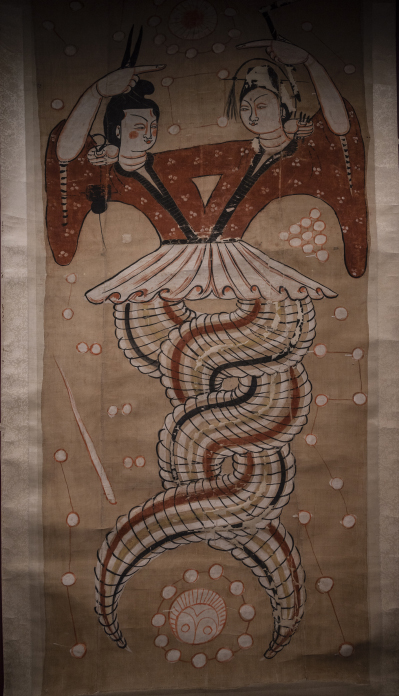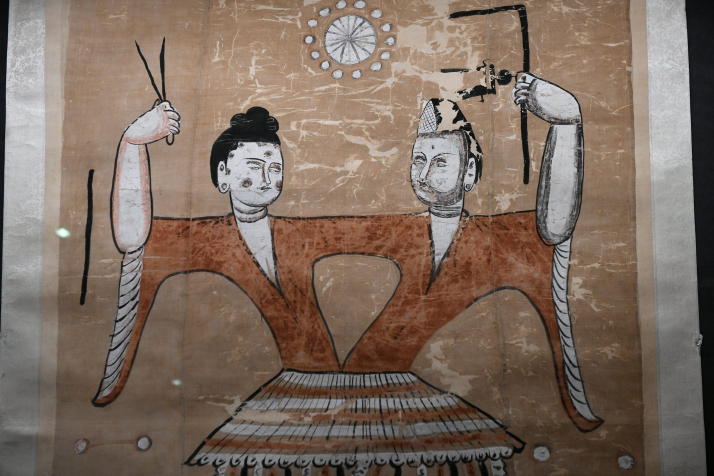| Xinjiang Today |
| Artworks provide clues to ancient exchange | |
|
|
 Colored Painting of Fuxi and Nüwa on Silk in the Xinjiang Uygur Autonomous Region Museum (VCG) Another painting depicts Fuxi and Nüwa with traits from China's Western Regions (VCG)
The arrival of the Year of the Snake is an opportune moment to explore serpents as a theme in Xinjiang's artistic heritage. In ancient times, serpent totems were revered as symbols of life, regeneration and mystery due to snakes' ability to shed their skin. Housed in the Xinjiang Uygur Autonomous Region Museum is a Tang Dynasty (618-917) national treasure titled Colored Painting of Fuxi and Nüwa on Silk, excavated in 1965 from the Astana Cemetery, an ancient cemetery in Turpan City. Nearly two meters tall, the painting depicts two figures, one male and one female, each with the head and upper body of a human and the tail of a serpent—their bodies embracing and their tails intertwined. Fuxi, on the right, holds a square raised above his head, while on the left, Nüwa raises a compass. Squares, used to measure the ground, represented the Earth, and the compass, used to study the heavens, represented the sky. The human-head and serpent-body depiction of the two is a fusion of mythology, philosophy, and early cultural beliefs. It reflects the reverence for nature, the balance of yin and yang, and the connection between humanity and the cosmos, making them enduring symbols of creation, unity and harmony in Chinese culture. In Chinese mythology, Fuxi and Nüwa are revered as the progenitors of humanity. Since the discovery of the first Fuxi and Nüwa painting in Xinjiang in 1928, archaeologists have unearthed over 100 similar works from the Astana Cemetery and the Jiaohe Ruins in Turpan, all dating to the period from the Jin to the Tang dynasties (265-907). The Xinjiang museum's artwork is among them. Burying the deceased with a painting of Fuxi and Nüwa is a custom that began in China's Central Plains region, or zhongyuan, commonly defined as the part of the North China Plain surrounding the lower and middle reaches of the Yellow River. The custom spread from there to the Western Regions, or xiyu, which includes today's Xinjiang, leaving clues for archaeologists and historians about cultural integration between these regions and their peoples.  Another painting depicts Fuxi and Nüwa with ethnic minority traits (VCG)
In the TV program National Treasure, Yu Zhiyong, Curator of the Xinjiang Uygur Autonomous Region Museum, explained the depictions of the figures in each painting provide clues about the people for whom they were painted: "The depictions of Fuxi and Nüwa vary. Some portray Nüwa with a phoenix crown, exuding nobility, while others show her with arched brows and almond eyes, radiating elegance. Similarly, Fuxi is sometimes painted with thick brows and a square face resembling a Central Plains noble, while others give him a bearded, high-nosed appearance akin to a Western Regions figure." This illustrates the multicultural coexistence and blending in the Turpan Basin during that era. Differences in attire are also evident: Some wear Han Chinese robes, while others don garments typical of the Western Regions. This suggests that the practice of placing Fuxi and Nüwa paintings in tombs was widespread at the time. Guo Sike, Curator of the Confucius Museum in Shandong Province, said in the documentary, "The intertwined serpent bodies of Fuxi and Nüwa, combined with the sun above, the moon below, and constellations along the edges, create a miniature cosmic environment within the tomb space." Scholars interpret this burial custom as reflecting ancestor worship, and a hope for the soul's eternal peace and return to its origins. Others argue the conjoined figures symbolize wishes for familial prosperity and flourishing descendants. In terms of artistic technique, most paintings exhibit the Central Plains tradition, using bold blocks of vermilion, purple, blue, green and yellow, with meticulous detailing that captures lifelike expressions through minimal brushstrokes. Some works, however, exhibit styles influenced by ancient Indian and Central Asian painting techniques. "Approximately 117 extant paintings of Fuxi and Nüwa—kept in China or dispersed to other countries such as the U.S., Japan, the Republic of Korea and India—were likely created during a period of intense cultural exchange between Turpan and the Central Plains," Wei Jun, former Curator of the Guangdong Museum said. "These works serve as a key to studying the westward transmission of Central Plains culture and the eastward influence of Western Regions art." (Print Edition Title: Common Heritage) Comments to maxiaowen@cicgamericas.com |
|
||||||||||||||||||||||||||||||
|